You may use LinkedIn to network with people in your field, Snapchat and Instagram to post amusing memes, and Facebook to reconnect with your college friends. However, how do you apply these social media channels to your business? Should you be on all the same channels? Post similar things? Connect in the same ways? To sum it up, what social media sites should your business be on?
You’re probably aware of how powerful social media is for business. According to Sprout Social, it’s common for customers to engage with brands on social media. Consider:
- 74 percent of consumers share video content from brands on social media
- 57 percent of consumers have reached out to a brand on social media because they had a question
- 45 percent of consumers reach out to brands on social media to get an issue with a product or service resolved, and 34 percent reach out to brands to tell them they’ve done a great job
Social media provides an instant way for your business to build relationships with customers. Customers expect your brand to be listening on social media. HubSpot reports 50 percent of customers will ditch a business that doesn’t respond to a negative social media post, and 80 percent of customers want a response within 24 hours.
Social media channels provide the following benefits for businesses:
- You can build brand awareness, which is especially important for new businesses
- You can provide customer support
- You can teach, educate, and inform customers about new products and services
- You can use social media to market your business
- You can build up a better business reputation by connecting with customers
So you know social media is essential for business. But what social media accounts should your business utilize? With dozens out there, let’s hone in on some of the most widely used ones and how you can put them to work for your business.
Facebook for Business
Facebook remains one of the world’s top websites, consistently ranking among the most visited platforms globally. It has consistently been one of the most downloaded apps from the App Store. Users continue to spend a significant amount of time on the site, with the average daily usage likely to be in line with previous estimates.
Leveraging social media, particularly Facebook, remains a strong method for promoting businesses and fostering connections with customers, thereby cultivating a loyal following. Moreover, in comparison to other marketing channels, Facebook offers cost-effective opportunities for business promotion. Establishing a Business Page is entirely free of charge, and expenses only arise if businesses opt to utilise Facebook’s advertising features for targeted campaigns. This affordability makes Facebook an attractive option for businesses of all sizes looking to expand their online presence and engage with their target audience.
Having a Business Page allows you to communicate directly with people who are aware of your business and want to learn more, as well as with potential customers. On your page, you can add your contact details, location, your brand story, and share information about your products, services, upcoming events, and more by using a combination of photos, videos, and text.
Set up and Optimise Your Business Page
The first step is creating a Facebook Page for your business (not a profile). However, to create a page, you must have a personal profile. Follow our simple step-by-step guide below to set up your Business Page. It is crucial to have your Facebook Business Page correctly optimised with SEO best practices in order to maximise online presence and therefore conversions.
Here are some tips on how to optimise your Facebook Business Page.
1. Set up the page
Go to facebook.com/business and click Start Now, and then Create a Page in the top right-hand corner. Select Business or Brand and click Get Started (you will need to sign into a personal account first). Write your business name, select a category for your business (I.e., bar, restaurant, etc.), and add your address and contact details.
2. Adding Your Profile and Cover Images
Ensure that the images you use reflect your brand identity and are readily recognisable as representing your business. Opting for your logo as the profile picture is a reliable choice; however, keep in mind that profile pictures are often cropped into a circular shape. Therefore, avoid placing important elements in the corners of the image to ensure they remain visible and intact.
The cover photo should be viewed as a billboard for your business so make sure you use a high-quality image that conveys the essence of your brand. The cover photo displays as 820 x 312 pixels on desktop and 640 x 360 pixels on mobile.
💡Top tip: Don’t forget to check the cover photo display on your mobile to ensure you aren’t cutting off the image or any key information.
3. Fill out your profile
Once your page is live, it’s time to add information about your business. Navigate to the About tab, where you can add a short description, additional contact details like the link to your website, Instagram handle and email address and other relevant information. Next step is to add a username, you can do this by clicking on Settings and General Page Settings. You must add your username in this step, as it’s how people can find you on Facebook.
Try to use your business name or some obvious variation of it to make it easy for people to remember. You should also add your opening hours and check that the business location is correct. Ensure that you have up-to-date information, without skipping any sections.
4. Organise your page tabs
To rearrange and turn certain tabs on and off, head to the settings, and click edit page. Some tabs will be more relevant to your page than others, so you can prioritise which ones you want customers to see first.
5. Create Engaging Content
By posting high-quality content that generates engagement, you will be actively improving your credibility online and improving SEO. You will also be prompting customers to take action, whether that is making a booking, completing a purchase or signing up to your mailing list.
Increase your Followers
Followers, likes and comments build trust with people who are researching businesses. As you grow your business, your Facebook followers are likely to also grow, but there are definitely steps to take to gain more followers, including:
- Engagement Campaigns (Facebook Page Like)
- Inviting people to like your page
- Host a social competition/giveaway
- Add a Facebook Like Widget on your website
- Utilise hashtags
- Get tagged by customers and other businesses
- Collaborate with other businesses
- Create content that is attention-grabbing and shareable
- Engage with your online community
Read also: 10 Social Media Trends You Need to Know in 2025
Share Content on Your Facebook Page
Your business’s Facebook page is like a free billboard. You should post new stuff on it often, but don’t bombard your followers. You can write your article and share it right away, or you can use the Meta Business Suite planner to choose a time and day for it to be shared.
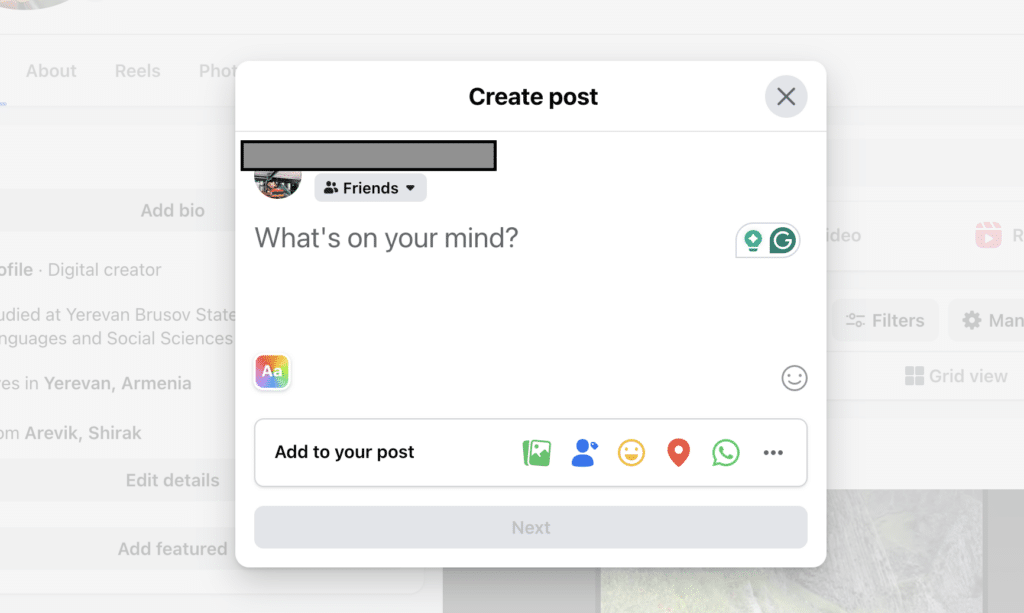
Different Types of Posts
You may share pictures and videos in a lot of different ways on Facebook, and there are also ways to help your business grow.
Photo/Video
This type is suitable for any type of content but especially for visually-driven content (e.g. a product highlight). A photo or image post can be scheduled to be posted at a later time.
Reels (Short-Form Videos)
Facebook Reels is a dynamic video format enriched with music, audio, AR effects, and various creative options. Reels are suggested based on relevance and may appear in your Feed and Video sections, among other places.
Link Post
A link post features an external link to a website. Although the preview link dominates the post, you still have room to craft a captivating caption. Simply paste the URL into your Create Post box to generate a link post. Facebook will automatically generate a preview of the website. Once the preview appears, you can remove the URL from the caption, and the link preview will remain intact.
Photo Album
To showcase photos from, for example, an event, you can create a photo album and upload as many photos as you’d like. Photo albums can’t be scheduled.
Photo Carousel
A photo carousel is great for showcasing a series of visuals, e.g. different products or services, and most importantly, the image itself is a click-through button to the destination you select, i.e. a certain page on your website.
Events
On your Facebook Business Page, you can set up events for specific events or happenings and promote to your Facebook followers, as well as targeted audiences. It’s a good way to spread awareness of your events, or specials, and promotions, as well as your brand.
The Facebook events can be a one-off event, an ongoing campaign or a recurring event (i.e,. weekly live music).

Offers
Facebook allows you to promote vouchers, discounts, and deals to your audience as a way to convert leads. You can choose to promote an in-store only offer, an online only offer, or a combination offer. To get the most out of your offers, try to keep it simple, use an eye-catching image, set an expiration dat,e and most importantly, make sure it’s an offer good enough for people to want to click on it.
Live
Facebook Live Video is a great way to show real-time moments and to interact with your audience. Your viewers can answer questions, post comments, and share their reactions.
Facebook Algorithm
The key point to understand is that Artificial Intelligence (AI) now plays a crucial role in the Facebook algorithm. With its advanced machine learning capabilities, AI tailors content for users by analysing their behaviour and preferences within the platform.
Below are several changes you can anticipate for 2025 from Hootsuite:
1. Increased emphasis on meaningful interactions
Facebook has emphasised its commitment to prioritising posts that foster conversations and meaningful interactions among its users. Posts with lower engagement levels might experience a decline in reach.
2. Relevance Score Calculation
Each post is assigned a relevance score by the algorithm, which determines its ranking in users’ feeds. Factors influencing this score include the nature of the content, user interactions with similar posts, and the duration users spend viewing posts within the same category.
3. Anticipated Post-Engagement Time
AI aids in predicting the duration users are likely to spend engaging with a post. This forecast considers signals like past interactions with similar content and the type of content within the post.
4. Diverse Mix of Content
The algorithm aims to offer users a diverse range of post types, including videos, photos, links, and text posts. This prevents users from being inundated with consecutive posts of the same type.
5. Enhanced User Transparency and Control
Facebook is committed to providing users with greater transparency and control. This includes features like “Show More, Show Less,” allowing users to customise their feed, and the option to switch to a chronological feed. Users can also create a “Favourites” list to prioritise content from their favourite accounts.
What Does It Mean for a Business Page?
As you may have realised by now, the algorithm makes it harder for businesses to reach people, and pages are likely to struggle with reach organically. Unless your audience is engaged with your page, your posts are likely not to make it into people’s feeds, as Facebook won’t deem the content as genuine and meaningful. The good news is that there are ways to increase your engagement, particularly through Facebook Advertising, and also for free by considering the content you post and who you are posting it for.
Try using the following tips to increase your organic reach:
- Understanding what your audience wants to see.
- Create accurate and authentic content.
- Post quality photos and videos that are more likely to catch people’s eyes.
- Include informative content.
- Engage with your audience – Ask questions in your post copy or in the comments.
- Tell a story – People like more human brands, making it easier for them to connect.
- Analyse your performance – Look at your top-performing content, what did your audience like, and what didn’t they like. Post at the right time for your audience
Advertise Your Business on Facebook
Facebook is a major part of people’s lives, and Facebook advertising is an important tool for businesses to connect with their audience. As we discussed in the previous chapter, the Facebook algorithm can make it difficult for you to organically reach your audience, but with Facebook ads, you can get your content in front of not only your audience but also the people who are most likely to be interested in your business.
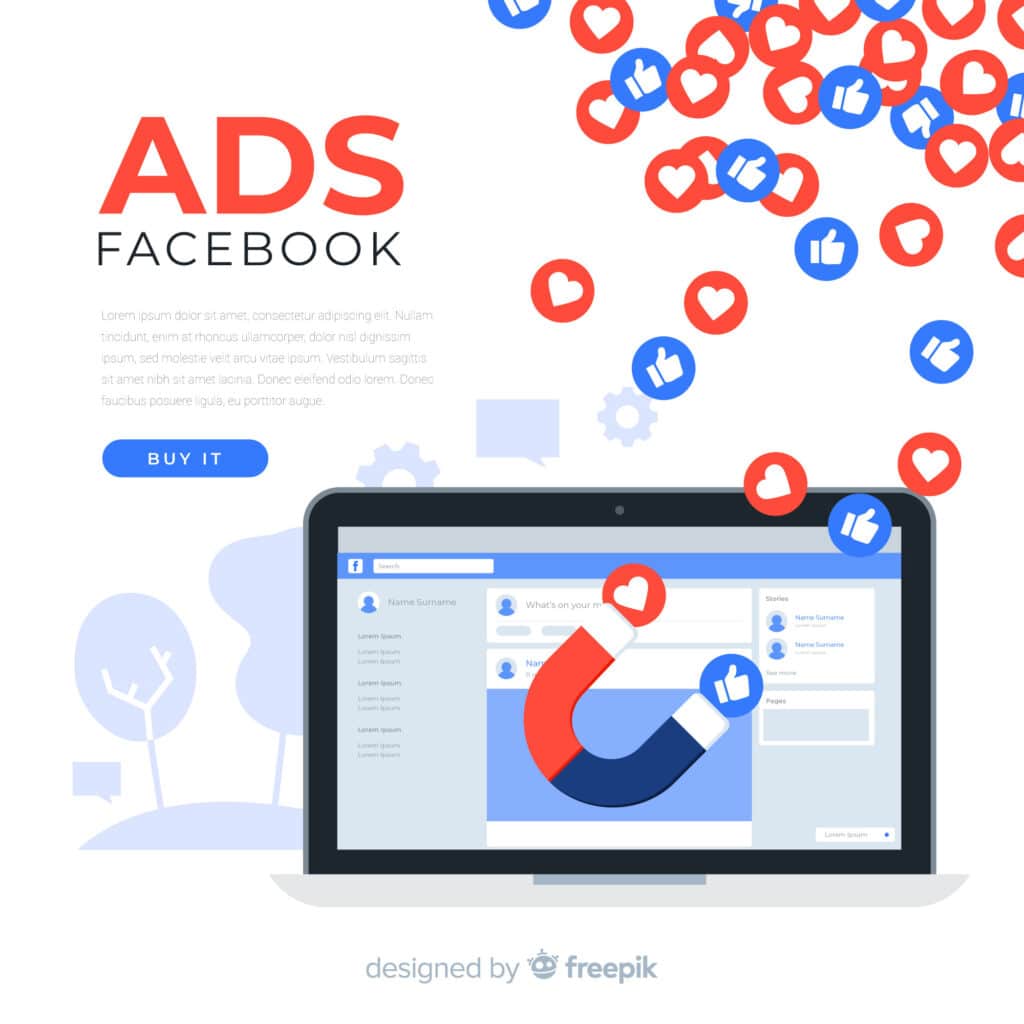
1. Exposure
The reality is that there are 2.11 billion daily active users worldwide. This vast user base presents a wealth of potential customers for businesses. Moreover, the ability for users to share ads further amplifies exposure, offering businesses significant reach and engagement opportunities.
2. Targeting
The data available on Facebook empowers businesses to precisely target their desired audience. Through advanced targeting options, advertisers can specify criteria such as age, gender, interests, behaviours, location, and more, ensuring that their ads reach the most relevant audience for their products or services.
3. Cost and Speed
Advertising on Facebook is much cheaper than traditional forms of advertising, such as billboards and television commercials. It is also much faster than traditional advertising as it is instant, with no waiting on production and print turnaround.
4. Reporting
Unlike some other forms of traditional advertising, Facebook Ads are completely measurable. All the data is laid out for you to see. The reports are also in real-time, allowing you to see the most up-to-date information on your ad campaigns. Real-time reports give you the ability to make changes if the ad campaign is not performing well.
Read also: Key Digital Marketing Trends for 2025
Get Started with Facebook Ads
To get started with Facebook Ads, you must create a Business Manager account and an Ad Account. We also recommend that you create and install a Facebook Pixel before you get started, as well as understand the difference between a boosted post and an ad.
1. Facebook Business Manager
The Business Manager is a tool that helps you manage your business, and you can’t create Facebook Ads without the Business Manager. To create an account, follow the steps below, but please note that you need to have a personal Facebook account to verify your identity.
- Go to facebook.com
- Click Create account
- Enter the name for your business, your name and your work email address.
Enter your business details and click Submit
2. Ad Account
The final step you have to do in order to set up a Facebook Ad is to create an ad account within the Business Manager. Your Ad Account must be linked to a credit card or a PayPal account for payments.
- Go to Business settings
- In the left column, click Accounts and click Ad Accounts
- Click + Add
- Choose one of the options presented: Add Ad Account, Request access to an Ad Account, or Create a new account.
- Follow the prompts to complete the setup.
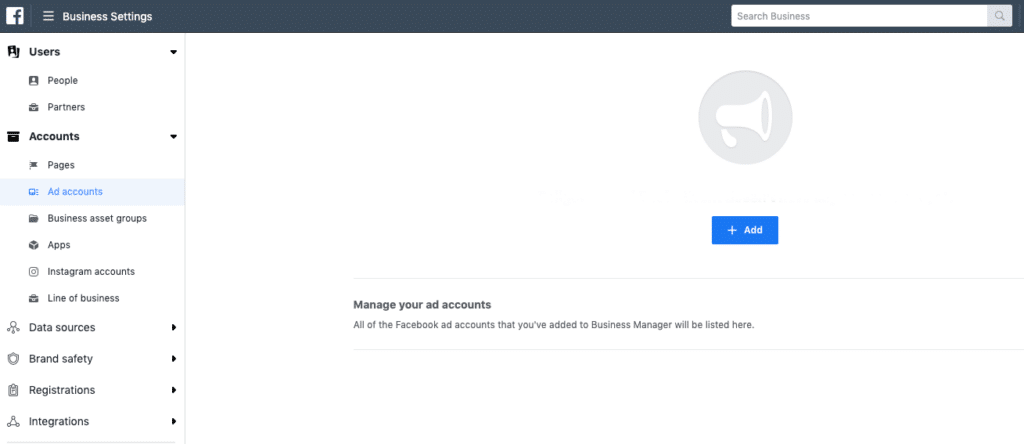
3. Meta Dataset/Sources
Meta Dataset enables you to consolidate and oversee event data originating from various sources, including your website, mobile app, physical store locations, or business chats, within a unified platform. Even if you’re not using Facebook ads at the moment, you should create a Meta Dataset as it will be helpful for you if you decide to so do as it starts collecting data as soon as it’s been activated. Learn how to do it here.
4. Boosted Post vs Dark Posts
Depending on the goals of your business, you may find that boosting posts are sufficient to reach your objective. Other times, ads (dark posts) are required. Whilst a boosted post is still considered an ad, a boosted post is a post published on your business page that you add money to to promote it to a targeted audience.
This is the simplest way to advertise and you boost the post directly from your business page, and as such boosted posts don’t require that you have Ads Manager. When you boost a post, you select your audience, a call to action, your budget and the duration of your campaign.
A Facebook Ad on the other hand, can only be created through Ads Manager and offer more advanced solutions than boosted posts. Generally speaking, if you want engagement or to increase brand awareness, boosting a post is a great way to increase the visibility but to create more advanced campaigns, Ads Manager is preferred. For best results, use a combination of boosted posts and Facebook ads.
5. Set Up Your Ads
Once you’ve set up your Business Manager Account and Business Page, you can follow the steps below on how to create a Facebook Advertising Campaign. Facebook advertising campaigns can be broken down into three parts: campaign, ad sets, and ads. You need all three to run an ad. Learn more about the different terminology in the Ad Glossary.
1. Choose a Campaign Objective
The very first step in creating an ad is to choose a Campaign Objective. Choosing the right campaign objective is what will decide if your campaign is successful or not.
The objective needs to serve your overall goal with the campaign and tells Facebook how and where to spend your budget to get you the best results.
There are three objective categories with further objectives within.
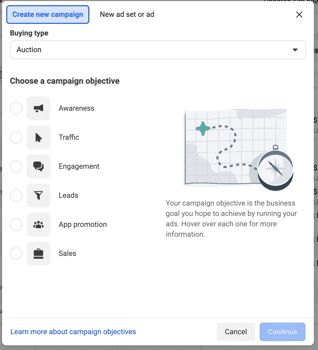
Awareness: As the name suggests, this objective aims to increase awareness about your business and offering.
- Brand Awareness: Increase people’s awareness of your business, brand or service.
- Reach: Show your ad to as many people as possible in your target audience.
Consideration: The consideration objective wants people to think about your business and seek more information.
- Traffic: Drive people from Facebook to a URL, such as your website’s landing page, a blog post, app, etc.
- Engagement: Reach people more likely to engage with your post. Engagement includes likes, comments and shares.
- App Installs: Send people to the shop where they can download your business’s app
- Video Views: Share videos of your business with people on Facebook most likely to watch it.
- Lead Generation: Collect leads for your business. Create ads that collect info from people interested in your product, such as sign-ups for newsletters.
- Messages: Connect with people on Facebook, communicate with potential or existing customers to encourage interest in your business.
Conversions: Basically, this objective is used to encourage people to take action on your business.
- Conversions: Encourage people to take a specific action on your business’s site, such as having them to add items to a cart, download your app, register for your site, or make a purchase.
- Product Catalogue Sales: Show products from your e-commerce store’s catalogue to generate sales.
- Store Visits: Promote your brick-and-mortar business locations to people who are nearby.
2. Choose Your Audience
There are many ways to target your desired audience. One of which is to use the demographic and interest options. This is usually utilised when targeting new people who haven’t previously interacted with your business.
Demographic constraints include location, age, gender and language. You can further define this audience in the Detailed Targeting section, which allows you to choose thousands of different demographics, interests and behaviours.
For example, you could target a 45-50-year-old man that has recently moved and is interested in cricket. The second way of targeting your desired audience is by using Custom Audiences. Custom Audiences allow you to target people who have already had an interaction with your business, whether through Facebook, Instagram, your website, your email marketing and more.
There are a number of categories of
Custom Audiences to choose from:
- Customer File: upload or import a data list and Facebook will cross-match it to find their Facebook profiles.
- Website Traffic: using the Facebook Pixel and conversion tracking, you can target to those who have visited your website.
- App Activity: target people who have completed a specific action in your app
- Engagement on Facebook: target people who have interacted with your content on Facebook, including events and video content.
- Engagement on Instagram: target people who have interacted with you content and profile on Instagram.
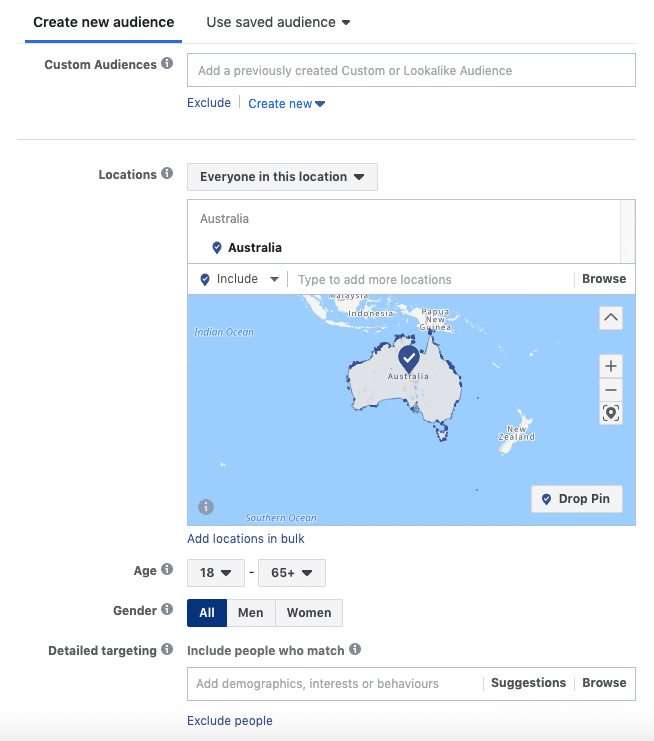
3. Choose Your Ad Placement
Ad Placements are the places where your ads appear and include Facebook, Instagram, Audience Networks and Messenger, which give you access to extend your ad reach away from social media and into apps and websites.
Knowing the best placement is important as it allows you to get the best results, but if you’ve only just started using Facebook Ads, it may be difficult to know what placement works best for you. Facebook will choose Automatic Placements by default and a good way to select your placement is to consider your target audience and where you think they are more likely to spend time and attention. Be sure to pay close attention to the distinction between stories and reels safe zones when creating ads on Meta.
This attention to detail is crucial for optimising your creative content. By understanding the specific dimensions and placement requirements for each format, you can ensure that your ads are displayed effectively and engagingly within their respective environments. This optimisation not only enhances the visual appeal of your ads but also maximises their impact and reach among your target audience.
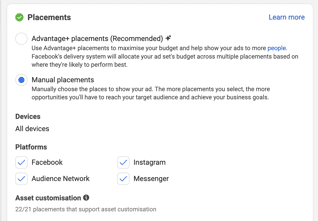
4. Choose Your Budget
As the name suggests, the budget is the amount of money that you want to spend for people to see your ad and there are two types of budgets.
- Daily Budget: The ad will run continuously throughout the day, and Facebook will pace your spending per day.
- Lifetime Budget: The ad will run at a specified length of your choosing. Facebook will pace your spending for this set time period.
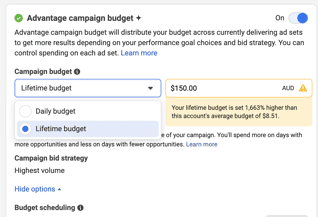
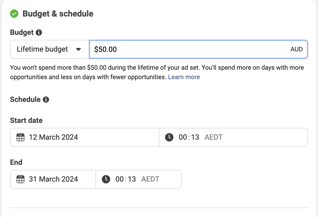
Measure Ad Results
1. Reach & Impressions
- Reach: The number of unique people who saw your ad.
- Impressions: The total number of times your ad was displayed (a single person may count for multiple impressions).
- Good for awareness campaigns.
2. Engagement Metrics
- Post Engagement: Total interactions (likes, comments, shares, clicks).
- Engagement Rate: Engagements divided by impressions or reach.
- Video Views: How many times your video was watched (with breakdowns like 3-second or 10-second views).
- Measures how well people connect with your content.
3. Click Metrics
- Link Clicks: Number of times people clicked links in your ad.
- Click-Through Rate (CTR): Link clicks ÷ impressions × 100.
- Cost per Click (CPC): Total spend ÷ link clicks.
- Best for traffic-driving campaigns.
4. Audience & Delivery Metrics
- Frequency: Average times one person saw your ad.
- Ad Relevance Diagnostics: Facebook’s quality ranking, engagement rate ranking, and conversion rate ranking.
Helps you see if the right people are seeing your ads.
Choosing the right social media channel for your business depends on understanding where your audience is, what your goals are, and what type of content you can consistently create. Each platform has strengths:
Facebook works well for broad reach, community building, and targeted ads.

